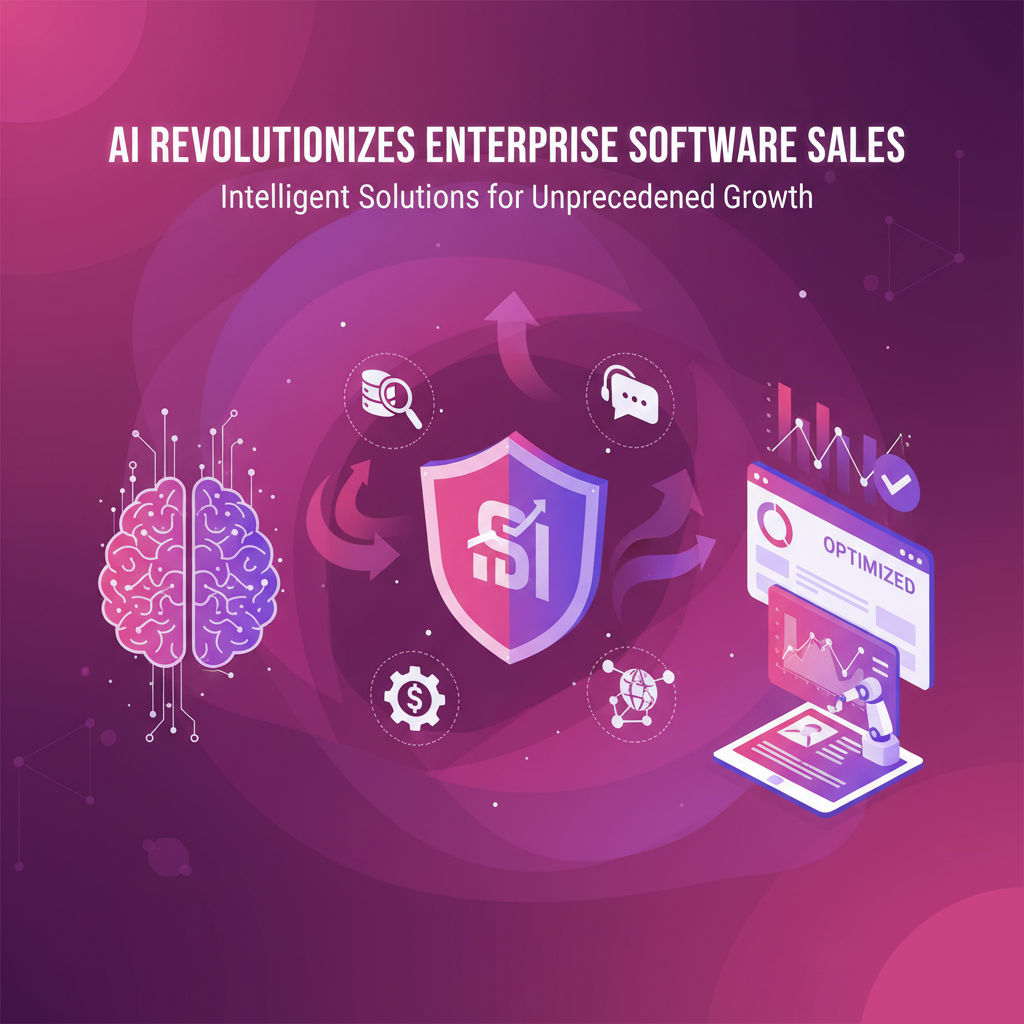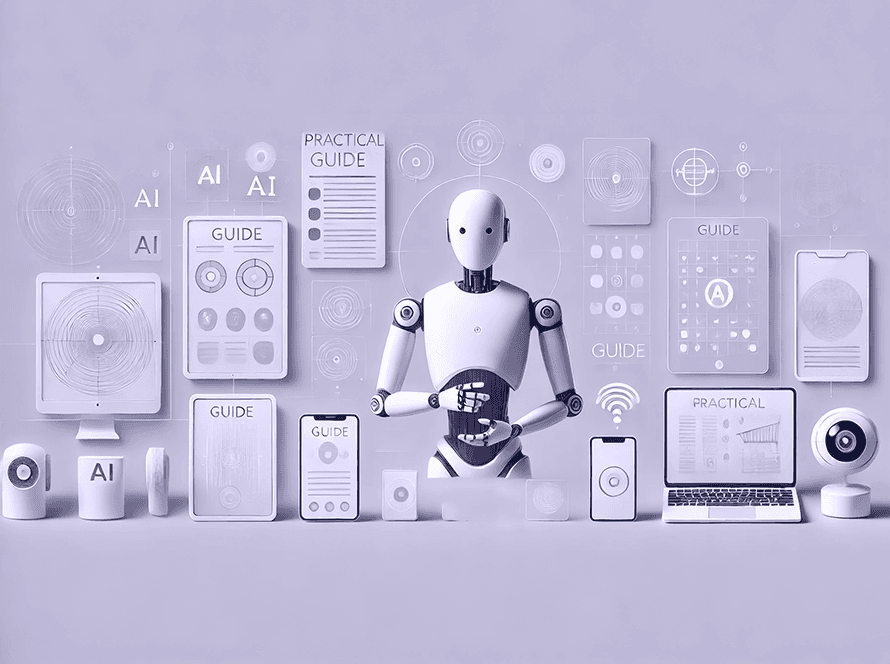“Boosting sales? AI for enterprise software sales automates account mapping & discovery, freeing AEs to focus on closing complex, high-value deals.”
Enterprise sales. It’s the big game. We call it “elephant hunting” for a reason. Landing a single logo can make your entire year. A deal with a Fortune 500 company means massive contract value, a powerful case study, and the kind of logo that opens doors everywhere else.
But let’s be honest. It’s also a brutal, soul-crushing grind.
The classic sales model is fundamentally flawed for enterprises. Your Account Executive (AE), your million-dollar closer, your “Wolf of Wall Street,” is spending upwards of 40% of their time not selling.
They’re not building business cases. They’re not charming the CFO. They’re not navigating the shark-infested waters of procurement.
Instead, they’re digging through LinkedIn Sales Navigator, trying to guess who the real VP of IT is. They’re sending hundreds of cold emails into a black hole. They’re playing an endless game of calendar tag, only to finally book a meeting with a mid-level manager who says, “This is great, but I’m not the right person. You need to talk to Susan.”
This is the central paradox of enterprise sales: the people best equipped to close high-stakes deals are often forced to spend their time on low-level administrative tasks.
The sales cycle is long. It’s a labyrinth. And it’s filled with people whose job seems to be saying “no.”
But what if there was a better way? What if your AEs could wake up to a calendar already filled with qualified discovery calls? What if you could deploy a strategic partner that works 24/7/365 to map an entire organization, identify every single stakeholder, and nurture them all simultaneously?
This isn’t a fantasy. This is precisely what AI for enterprise software sales is built to do. It’s not about replacing your sales team; it’s about arming them with a co-pilot that handles the air war so they can win the ground war.

The Labyrinth: Why the Enterprise Sales Cycle Is a Nightmare
To understand the solution, we must first truly appreciate the problem. Why is selling software to a large company so agonizingly complex? It boils down to a few key areas.
The Multi-Stakeholder Monster
In a small business (SMB) deal, you typically sell to a single person: the owner. They hold the problem, the budget, and the authority to sign the check. You get one “yes,” and the deal is done.
In an enterprise deal, there is no “one person.” You are selling to a “buying committee,” a shadowy group of 10, 15, or even 20 people, all of whom have a vote. A single “no” from the right person can kill a deal that’s been in the works for a year.
This committee is a cast of characters, each with their own language, motivations, and fears:
- The Champion: This is your inside person. They feel the pain your software solves. They will fight for you, but they often lack final budget authority.
- The Economic Buyer: This is the CFO or a high-level VP. They don’t care about your features. They care about one thing: ROI. They speak in spreadsheets, total cost of ownership (TCO), and payback periods.
- The Technical Buyer: This is the CIO, CTO, or Head of IT Security. They are the gatekeepers. They don’t care about the ROI if your solution opens a single security vulnerability or fails to integrate with their outdated, home-grown ERP system.
- The User Buyers: These are the department heads and end-users who will actually use your software. If they find it clunky or see it as a threat to their jobs, they will sabotage the deal through apathy.
- The Blockers & Influencers: This group includes Legal, Procurement, and Compliance. Their job is not to buy things; it’s to mitigate risk. They are paid to identify issues in your contract, data privacy policy, and pricing.
The core challenge? You cannot send the same message to all of them. A value prop for the CFO is technical jargon to the user buyer. A security-focused message for the CIO is boring to the Champion.
This requires deep multi-stakeholder communication. Your team must manually orchestrate a dozen different conversations, all in perfect harmony, just to reach the first call.
The 18-Month Time Abyss
The average B2B sales cycle for an enterprise typically ranges from 12 to 18 months. Sometimes longer.
Think about that. An AE can work on a deal for an entire year only to have it dissolve due to a budget freeze, a reorganization, or a new executive sponsor who wants to “re-evaluate all vendor relationships.”
This creates an enormous challenge: nurturing long sales cycles. A human AE simply cannot maintain persistent, patient, and valuable follow-up with 15 stakeholders across 50 different accounts for over a year. It’s impossible.
They focus on the “hot” deals, and the “maybe next quarter” deals go dark. When the AE finally follows up six months later, the prospect has forgotten who they are, the champion has left the company, and a competitor has taken their place.
The Black Box of Account Mapping
The first step in any enterprise deal is determining who to contact. This is where account-based marketing (ABM) execution so often fails.
Marketing builds a beautiful target account list. They hand it to sales. The AE looks at the first name on the list, “GlobalCorp Inc.,” and thinks, “Great. Who at GlobalCorp?”
They don’t have an org chart. They are unfamiliar with the political landscape. They don’t know who reports to whom.
So, they start the manual grind. They spend hours on LinkedIn, trying to piece together the puzzle. They send a “shot in the dark” email to the CIO, which gets instantly deleted. They try a VP of Operations, who’s on vacation.
This initial phase of simply finding the door is the single biggest time-sink for highly paid AEs. You’re asking your best closers to be genealogists. This manual approach to automating discovery for enterprise deals is a failure before it even begins. It doesn’t scale, and it burns out your best people.
The Old Way vs. The New Way: A Tale of Two AEs
To illustrate this, let’s examine a day in the life of two enterprise Account Executives. Both are talented. Both are driven. However, one is stuck in the past, while the other is leveraging AI for enterprise software sales.
Meet “Manual Mark” (The Old Way)
8:00 AM: Mark grabs his coffee and opens his CRM. He has a list of 50 target accounts for the quarter. He picks one: “MegaPharma LLC.”
8:15 AM – 10:30 AM: He opens LinkedIn Sales Navigator. He searches for “VP of Supply Chain,” “Director of Logistics,” and “IT Procurement” at MegaPharma. He finds 25 potential contacts. He doesn’t know which ones are on the buying committee, so he just exports them all.
10:30 AM – 12:00 PM: Mark copies and pastes a generic email template. “Hi [Name], I see you work at MegaPharma and thought you might be interested in our revolutionary logistics platform…” He sends this to all 25 contacts, praying one of them is the right person.
1:00 PM – 3:00 PM: He gets three replies.
- One is an “Out of Office” message.
- One is a curt “Not interested.”
- One is a “You’ve got the wrong person. I’m in marketing.”
3:00 PM – 5:00 PM: Mark feels defeated. He spent his entire day prospecting and has zero meetings to show for it. He hasn’t built a business case. He hasn’t run a demo. He hasn’t moved a single deal forward. He was an “email robot,” and a bad one at that.
Meet “Strategic Sarah” (The New Way)
8:00 AM: Sarah grabs her coffee and opens her calendar. She sees three new meetings:
- 9:00 AM: Discovery Call w/ VP of Supply Chain @ MegaPharma
- 11:00 AM: Technical Deep Dive w/ Director of IT @ GlobalRetail Corp
- 2:00 PM: Intro Call w/ Procurement Lead @ Apex Logistics
8:00 AM – 9:00 AM: Sarah reviews the briefing report for her first call. Her AI Sales Agent, “Alex,” has already done the heavy lifting. The report contains:
- The VP’s name, title, and recent LinkedIn posts.
- The full email exchange “Alex” had with the VP and his executive assistant to book the meeting.
- Intel gathered from other conversations. The AI also spoke to a Director of IT (who is being looped into the 11 AM call) and a compliance manager (who raised a concern about data sovereignty).
9:00 AM – 10:00 AM: Sarah crushes the discovery call. She’s not “finding a door”; she’s walking through it. She already knows the key players and their potential objections. She’s operating as a high-level strategic consultant from the very first minute.
The rest of Sarah’s day: She spends her time in high-value conversations, building rapport, and navigating the internal politics of her deals.
What was Sarah’s AI doing while she was in meetings?
It was prospecting “Titan Manufacturing.” It identified 12 likely stakeholders across four departments. It crafted and sent 12 different, hyper-personalized emails. It was handling the “not the right person” replies intelligently, pivoting to new contacts, and working 24/7 to fill Sarah’s pipeline for the next week.
Sarah isn’t an appointment setter. She’s a deal captain. That’s the difference.
The AI Co-Pilot: How AI Actually Automates the Hard Stuff
This isn’t magic. It’s a fundamental shift in process. AI, and specifically AI agents, are not just “tools.” They are autonomous team members. Here is how advanced enterprise sales tools powered by AI execute this strategy.
Step 1: Intelligent Account Mapping and Persona ID
You can’t simply throw an AI at a website and say, “Go.” You must first define the strategy. You provide the AI with your Ideal Customer Profile (ICP) and the “personas” you need to reach.
- You define: “We sell to F500 retail companies in North America. We need to talk to the VP of E-commerce, the Director of IT Security, and the Head of Finance.”
The AI then ingests this. It doesn’t just scrape LinkedIn. It cross-references multiple data sources—company reports, press releases, job postings, and data providers—to build a dynamic “influence map” of the target account. It identifies the most likely champions, buyers, and blockers. This is enterprise lead qualification on steroids.
Step 2: Autonomous, Multi-Threaded Outreach
This is the most critical part. The AI doesn’t just “blast” an email. It runs a sophisticated, complex sales automation campaign.
It crafts unique, persona-based messaging for each stakeholder.
- To the VP of E-commerce: “Your latest earnings call mentioned a push for higher cart conversion. Our platform integrates directly with your stack to reduce checkout friction by 30%. Worth a 15-min chat?”
- To the IT Security Director: “I’m sure your team is evaluating vendors for SOC 2 Type II and GDPR compliance. Our platform is fully compliant and can reduce your team’s security review overhead. Can I send over our data-handling one-pager?”
- To the Head of Finance: “Enterprise platforms often come with hidden integration costs. Our model is all-inclusive, showing an average TCO reduction of 22% for companies of your scale. Open to a brief call to review a sample business case?”
The AI then manages these dozens, or even hundreds, of conversations in parallel. It works 24/7. It never forgets to follow up. It follows the precise, patient cadence required to nurture long sales cycles.
Step 3: Gather Intelligence and Navigate Objections
This is what separates an actual AI agent from a simple “bot.” A simple bot breaks the moment it gets a human reply. An AI agent learns.
- Objection: “I’m not the right person for this.”
- AI Response: “My apologies, [Name]. Appreciate you letting me know. Who would be the best person to speak with regarding e-commerce platform performance?”
- Intel Gathered: “We just signed a 2-year contract with your competitor.”
- AI Response: “Understood. It sounds like you’re locked in for now. I’ll make a note to check back in 18 months when you’re re-evaluating. In the meantime, many of our clients utilize us for [Secondary Use Case] in conjunction with that platform. Any interest there?” (The AI then logs this “contract end date” in the CRM for the AE.)
- Objection: “We don’t have the budget for this until Q4.”
- AI Response: “That’s perfectly fine. I’m not trying to sell you anything today. Most of our enterprise clients set their budgets 6 to 9 months in advance. Would it make sense to have a preliminary chat now, so that you have the right numbers for your Q4 planning?”
The AI is performing automated discovery for enterprise deals. It’s mapping the org chart, identifying pain points, and uncovering budget cycles before your expensive AE ever joins the call.
Step 4: Book the Qualified Meeting, Deliver the Briefing
The AI’s sole goal is to book meetings with decision-makers.
Once a stakeholder shows interest, the AI handles the entire scheduling process. It integrates with your AE’s calendar, offers up available times, and navigates the “I’m not free then, how about Tuesday?” back-and-forth.
When the meeting is confirmed, it sends the calendar invite, cc’s the AE, and—most importantly—compiles a complete executive briefing. The AE receives:
- The booked meeting.
- The whole conversation history.
- A summary of all other stakeholders the AI has identified or spoken to.
- Key intel like “they are concerned about integration” or “their champion is Jane Doe.”
Your Account Executive is now 100% focused on what they do best: closing.
The Specialist: Why SalesCloser.ai Is Your Strategic AI Partner
The market is flooded with “AI” tools. Most are simply thin wrappers around ChatGPT, designed to help you write emails more efficiently. This is not enterprise-grade.
Writing emails isn’t the bottleneck. The execution is the bottleneck.
This is where SalesCloser.ai comes into play. It’s not a “writing assistant.” It is an autonomous AI sales agent explicitly designed for the complexities of B2B enterprise sales. It acts as a dedicated and tireless Sales Development Representative (SDR) for each of your Account Executives.
Here’s how SalesCloser.ai operationalizes this entire strategy, moving beyond simple tools into proper strategic account management.
It’s a Fully Managed Agent, Not Just Software
You don’t “log in” to SalesCloser.ai to write emails. You deploy it.
- Strategy Kick-off: You meet with an enterprise strategist. You define your target accounts (ABM lists), your ICP, and your core value propositions.
- Persona-Crafting: The SalesCloser.ai team, aided by its powerful AI, crafts the specific, multi-threaded messaging campaigns for your target personas. This isn’t a generic template; it’s a bespoke sales playbook.
- Activation: You “turn on” the agent. It autonomously builds the contact lists for your target accounts. It identifies the VPs, directors, security leads, and finance chiefs.
- Execution & Learning: The agent begins its 24/7/365 outreach. It runs the campaigns, handles the replies, navigates the objections, and learns from every single interaction. It gets smarter over time, learning which messages resonate best with a CIO versus a CFO in your specific industry.
- The Handoff: The only thing that lands on your AE’s desk is a qualified, booked meeting with the right person at the correct account.
Built for ABM and Multi-Threading
SalesCloser.ai was built from the ground up for account-based marketing (ABM) execution. It thrives on the very complexity that crushes manual teams.
Want to target 100 enterprise accounts? No problem. SalesCloser.ai can spin up an agent for each one.
Want to contact 15 different stakeholders within each of those accounts? That’s what it’s designed for.
This is multi-stakeholder communication at a scale that is simply not possible for a human team. Your AEs can now manage a portfolio of AI-driven campaigns, stepping in only when a human touch is required.
It Frees Your AEs for High-Value Work
Let’s be clear about what SalesCloser.ai doesn’t do.
It doesn’t run your complex product demo.
It doesn’t build a multi-million dollar business case.
It doesn’t negotiate the Master Service Agreement (MSA) with the legal team.
Thank goodness. Because these are the things your AEs should be doing.
By handing off the entire top-of-funnel—prospecting, account mapping, discovery, and appointment setting—SalesCloser.ai frees your most valuable sales assets to focus on the delicate, human-centric tasks of closing a deal.
It lets them spend their time building relationships, aligning with executive sponsors, and expertly navigating procurement processes. You’re finally letting your closers close.
The AE of the Future: From Prospector to Deal Captain
This brings us to a critical, and often feared, topic: “Will AI replace my sales team?”
The answer is an emphatic no.
But it will change the job description. And frankly, it’s for the better.
The role of the enterprise AE is being split into two:
- The “Top-of-Funnel” (The Grind): Finding accounts, identifying contacts, sending cold emails, and booking meetings.
- The “Mid-to-Bottom-of-Funnel” (The Strategy): Running demos, building consensus, delivering value, negotiating, and closing.
AI is rapidly commoditizing and automating the first part. The AEs who build their careers on being “great prospectors” will be in trouble.
The AEs who thrive will be the “Deal Captains.” These AEs are strategic partners to their clients. They are masters of:
- Political Navigation: They can map the internal power structure and align stakeholders.
- Business Acumen: They can talk to a CFO about TCO and to a CIO about API integrations with equal confidence.
- Project Management: They can manage a 12-month pilot program, keeping all parties engaged.
- Procurement & Legal: They know how to shepherd a deal through the final, painful-but-necessary stages of legal and procurement reviews.
AI for enterprise software sales doesn’t replace this person. It creates them. It gives them back 40% of their week, which they were wasting on administrative drudgery, and allows them to be the high-impact deal closers they were hired to be.
Conclusion: Stop Prospecting, Start Closing
The enterprise sales cycle is a labyrinth by design. It’s complex, lengthy, and designed to test the patience and persistence of any sales team. For decades, we’ve accepted that the cost of entry for this “big game” is a massive, manual effort of cold prospecting.
That era is over.
Your best AEs are not appointment setters. Your best AEs are not data-entry clerks. Your best AEs are strategic closers. It’s time to let them do their job.
Using AI agents like SalesCloser.ai to run the top-of-funnel is no longer an “edge”; it’s a competitive necessity. It allows you to execute a perfect, multi-threaded ABM campaign at scale. It nurtures deals through the long, cold winter of the sales cycle. It maps the accounts, identifies the buyers, and books the meetings.
It gives your team the one thing they truly need: a chance to sell.
Stop asking your elephant hunters to dig for traps. Give them a co-pilot, point them at the target, and let them do what they do best.
Frequently Asked Questions (FAQs)
Q1: Will AI really replace my enterprise sales team or my SDRs?
No, it redefines their roles. AI automates the most repetitive, high-volume, low-success-rate part of the job: top-of-funnel prospecting and appointment setting. This frees up your SDRs to focus on qualifying the inbound leads that AI generates, and it frees your AEs to focus 100% on closing deals. Think of it as promoting your whole team to a more strategic position.
Q2: How is this different from a simple email automation tool like Outreach or SalesLoft?
Those are great tools, but they are “dumb” automation. You still need to find the contacts, write all the copy for every sequence, and manually handle 99% of the replies. An AI agent like SalesCloser.ai is autonomous. It identifies the contacts, creates persona-based copy, and manages the replies. It’s the difference between a hammer (Outreach) and a carpenter (SalesCloser.ai).
Q3: How can an AI possibly handle complex, human objections?
The AI is trained to handle first-level objections, which make up the vast majority of replies (e.g., “not the right person,” “no budget,” “send me more info,” “I’m busy”). Its goal isn’t to debate a technical expert. Its goal is to identify interest and book a meeting. If a prospect replies with a complex, high-intent buying question, the AI’s job is to recognize that and immediately loop in the human AE. It acts as a perfect filter.
Q4: We have a very specific, technical ICP. Can an AI really understand our business?
Yes. A platform like SalesCloser.ai isn’t a generic, off-the-shelf bot. It’s a managed solution. The process begins with a deep strategy session where the AI is trained on your value proposition, your ICP, your case studies, and your technical language. It learns what a “Director of Data Governance” at a bank cares about versus a “VP of Logistics” at a retail company. The customization is the key.
Q5: How does AI help with the later stages, like navigating procurement processes?
This is a key distinction. The AI itself doesn’t navigate procurement processes. What it does is free up the AE’s time, allowing them to dedicate their full attention to this critical human-to-human stage. While the AI is prospecting 50 new accounts, your AE is spending their week building a relationship with the procurement lead, walking the legal team through the MSA, and ensuring the deal doesn’t die in the final mile. The AI handles the start of the race, allowing the AE to win the end of it.








